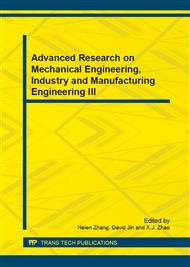p.205
p.209
p.214
p.218
p.223
p.228
p.233
p.238
p.243
Preparation Technology and Mechanical Properties of Fe-C Composites Fabricated by Plasma Activated Sintering
Abstract:
The Fe-C composites were fabricated by a combination of high-energy ball milling of Fe-C powder mixtures and plasma activated sintering process. An orthogonal experiment in four factors (including original powder composition, sintering temperature, applied pressure and holding time) and three levels was employed to investigate the effects of preparation technology on mechanical properties (bending strength and hardness) of the Fe-C composite. The experimental results show that the crystalline Fe3C phase can be produced by the rapid sintering process, though it is cannot form theoretically due to the high Gibbs free energy, and more or less holes and composition segregation phenomenon coexist in the composite. The original powder composition plays the leading role in both the mechanical properties of the Fe-C composites. However, the effects of the other parameters on the bending strength and hardness of the composite are somewhat different. The optimal technology combinations for the bending strength and hardness are obtained as follows: 50Fe+50Fe3C/1373 K/400 s/20 MPa and 50Fe+50Fe3C/50 MPa/1273 K/400 s, respectively.
Info:
Periodical:
Pages:
223-227
Citation:
Online since:
August 2013
Authors:
Keywords:
Price:
Сopyright:
© 2013 Trans Tech Publications Ltd. All Rights Reserved
Share:
Citation:


